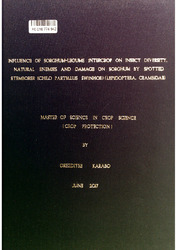| dc.description.abstract | Stemborers are considered major pests of sorghum (Sorghum bicolor (L) Moench) in Botswana. An evaluation of the effect of intercropping sorghum with legumes on insect diversity, natural enemies and damage on sorghum by stemborers was conducted in the 2015/2016 cropping season at Botswana University of Agriculture and Natural Resources in Sebele, Gaborone. Sorghum was intercropped with four different legumes namely cowpea (Vigna unguiculata (L) Walp.), groundnut (Arachis hypogea L.), Bambara groundnut (Vigna subterranean (L.) Verde.) and chickpea (Cicer arietintim L). The study showed that intercropping significantly increased insect species composition and diversity. There were more herbivores than predators and the predominant insect herbivore found infesting sorghum was Melanaphis sacchari (Zehntner) followed by Chilo partellus (Swinhoe). Principal component analysis and cluster analysis showed that the insect species were separated between the monocrop and intercrop systems. There was a significant difference (P< 0.05), in level of parasitism between the monocrop and intercropping systems. More parasitoids of the stemborer were found in the intercrops especially in the sorghum groundnut intercrop that had more species than the other intercrops and none were found on the sorghum monocrop. There was no significant difference (P>0.05) in the density of predatory Coccinellidae and Syrphidae but numerically they were predominant in the sorghum-legume intercrops. The predator prey relationship showed a pattern consistent with a functional response. The study also showed that intercropping significantly reduced stemborer infestation and damage compared to sorghum monocrop where high levels occurred. A significant (P> 0.05) reduction in the number of larvae per plant, number of stem tunnels and stem tunnelling length occurred on intercrop than on monocrop system. Proportions of plants with dead hearts, whorl leaf damage and number of moth exit holes did not vary significantly between the sorghum intercrop and monocrop. Grain yield of sorghum increased significantly (P>0.05) where sorghum was intercropped with grain legumes than on monocrop. Multiple regression analysis using the best subsets procedures showed that the predictor model included number of larvae per plant, number of stem tunnels and stem tunnelling length. The model indicated that a significant reduction in yield was related to the number of larvae per plant, number of tunnels and tunnelling length, accounting for 72.4% of the variation in sorghum grain yield. The calculated Economic Injury Level (EIL) of sorghum intercrops ranged between 3.00-8.39 larvae per plant. Sorghum-Bambara groundnut intercrop had the highest cost to benefit ratio and lowest cost of intercropping indicating that this combination was the most cost effective system able to reduce stemborer damage below economic damage. These results show that intercropping sorghum with grain legumes reduces stemborer damage and consequently increases yield potential of sorghum. | en_US |

